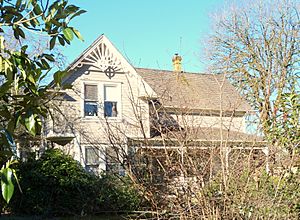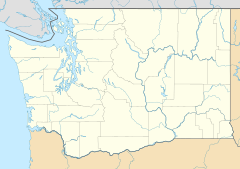Heisson, Washington facts for kids
Quick facts for kids
Heisson
|
|
|---|---|

The historic Henry Heisen House
|
|
| Country | United States |
| State | Washington |
| County | Clark |
| Elevation | 430 ft (130 m) |
| Time zone | UTC-8 (Pacific (PST)) |
| • Summer (DST) | UTC-7 (PDT) |
| Area code(s) | 360 |
| GNIS feature ID | 1520677 |
Heisson is a small, quiet community in Clark County, Washington, USA. It's not a city or town with its own government, but rather an "unincorporated community."
Heisson is located just north of Battle Ground Lake State Park. It lies south of the East Fork Lewis River. The community is also northeast of the town of Battle Ground, Washington. Heisson has a general store that also serves as the post office. There are also several houses in the area. One special house there is the Henry Heisen House. It's so old and important that it's listed on the National Register of Historic Places. You can find the post office right next to the tracks of the old Chelatchie Prairie Railroad.
The Story Behind Heisson's Name
Heisson got its name from a German immigrant named Alexander Heisen. He and his family settled here way back in 1866. The name "Heisson" is actually a mistake in spelling.
Alexander Heisen gave some of his land to the government. This land was used for logging. In return, he asked for the new post office to be named after him. The post office was started in 1904. But when it was officially recorded, someone wrote "Heisson" instead of "Heisen." Only the railroad kept using the original "Heisen" spelling. Today, the general store, post office signs, and maps all use the "Heisson" spelling.
The Historic Henry Heisen House
Alexander Heisen's son built a home in the area. This house is known as the Henry Heisen House. It is listed on the National Register of Historic Places. This means it's a very important historical building. The house is currently owned by Heisen House Vineyards.
Heisson's Early Days
Heisson was a busy place for a while. This was especially true until 1923. The town thrived because of the timber industry. Workers from the Ryan and Allen Mill lived there. This mill was located across the East Fork Lewis River. But after 1923, most of the timber was gone. The workers started to move away. This caused the town to become much quieter.



